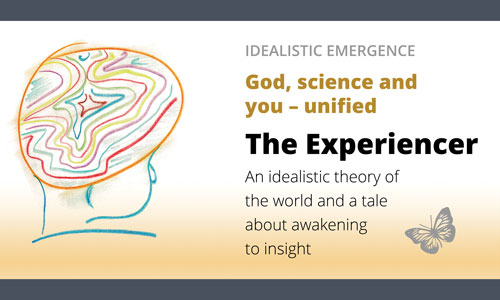Well, no, listen now – everything works precisely as science tells us. All the processes we know work as before. We only have to reverse cause and effect, which is no small thing.
The brain is a bit spooky, unbelievably complex.
It has an insane capacity, which may be even greater than we think because the brain is probably engaged in «complexity computing».
We tend to compare everything possible with today's technology, which is currently binary computers.
Forget this.
The design and function of the brain must, like everything else in an idealistic universe, follow the laws of mental complexity, those about attractors, feedback loops, the butterfly effect, etc.
The brain is thus ultra-dynamic and everything plays in symphony with everything. It multitasks in infinities of layers, levels of detail, specialisations and dimensions.
Where a traditional computer normally processes 64 parallel processes simultaneously (64-bit architecture), the whole brain is probably potentially active simultaneously. This gives a much, much larger capacity.
The content of the processed information also probably interacts with the brain's structure so that they optimise each other. We can actually observe this.
There are videos, e.g. this1, which show how the neurons in the brain appear as a living mass in constant flux. The nerve pathways in the brain are not a fixed, static structure. The brain «lives with» what it processes.
In our idealistic worldview, information and «machine» are essentially identical. When information changes, the experience of the information – that is, the brain – must also change. I would argue that this further indicates that we are in on something.
Yes, information is abstract, while the brain is experienced as something organic, physical. But in a world where everything is fundamentally abstract, it is difficult to distinguish between «software» and «machine».
Nothing in the brain is static, and everything contributes to the whole. It is a form of information processing foreign to us today, but the relationship to artificial intelligence (AI) is clear. In AI, there is continuous learning and reprogramming based on previous knowledge and the status at all times.
The conclusion is that the brain has an insane power to produce «reality».
In my view, the brain is a generator, not something that receives and interprets external impressions. The experience of particles and everything else we experience as material is «formed» – in fact – by observation.
The observer effect in quantum physics is thus real.
An «observation» is not something that comes after an event but before.
The notion of particles and everything else in the universe is first formed mentally as ideas in the experienced brain. This, in turn, leads to an emergent interpretation of the events as there being something «outside» the brain, namely an «eye», which sends «signals» to the brain. These signals must again be understood as something – as objects out there in the vast world around us.
It is these objects, the highest emergent interpretation, we experience.
The whole thing is a fluctuating chain of emergence, where the notions follow each other so that a rich «reality» emerges.
According to science, the eye is also supposedly an extension of the brain, an outgrowth in the biological sense. This indicates that the eye itself also helps to generate reality, together with the rest of the brain.
There is a lot of research on the brain, and we know that:
- The brain is often at the forefront of sensory impressions.
- We also know that the brain fills in, fantasises, and generates experiences that have no origin in any external world but are nevertheless experienced as such.
- More signals go out to the eyes than back to the brain. That indicates that the eyes project more than they receive.
- We know that when people take hallucinogens, such as LSD or psilocybin, the activity in the brain decreases, while the subjective experiences increase in strength and scope – and introduce completely different experiences than those we otherwise have. They obviously do not come from the brain.
- The same thing happens regarding NDE, i.e. near-death experiences. They can be studied when people lie on the operating table after a heart attack or an accident, the brain activity abruptly ceases, and the heart stops beating. The patient is clinically dead but wakes up alive a while later and tells about the most wonderful experiences. They can not have their origin in the brain; there was zero activity.
Millions of observations and reports of near-death experiences have been documented worldwide from the 1960s until today. They are mostly consistent in their content and cannot be rejected as a whole.
I could give you many, many examples of the various phenomena. They are carefully studied and scientifically documented. That is not where the problem lies.
The challenge is concealment, trivialisation, denial, suspicion, condescension, bigotry, arrogance, abuse of power, etc., in the scientific community.
It is within studies of the brain that the schism between idealism and materialism is most inflamed because there are lots of reasonable indications, often outright evidence, that materialism fails.
The understanding of this is progressing slowly but not fast enough. One day there will be a breakthrough – maybe in ordinary people before the scientists.
It is said that science evolves a small step every time a professor dies.
We do not have time to wait.
